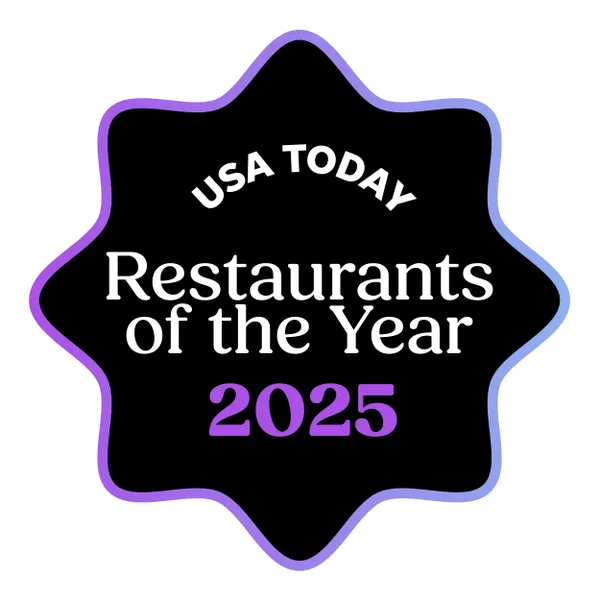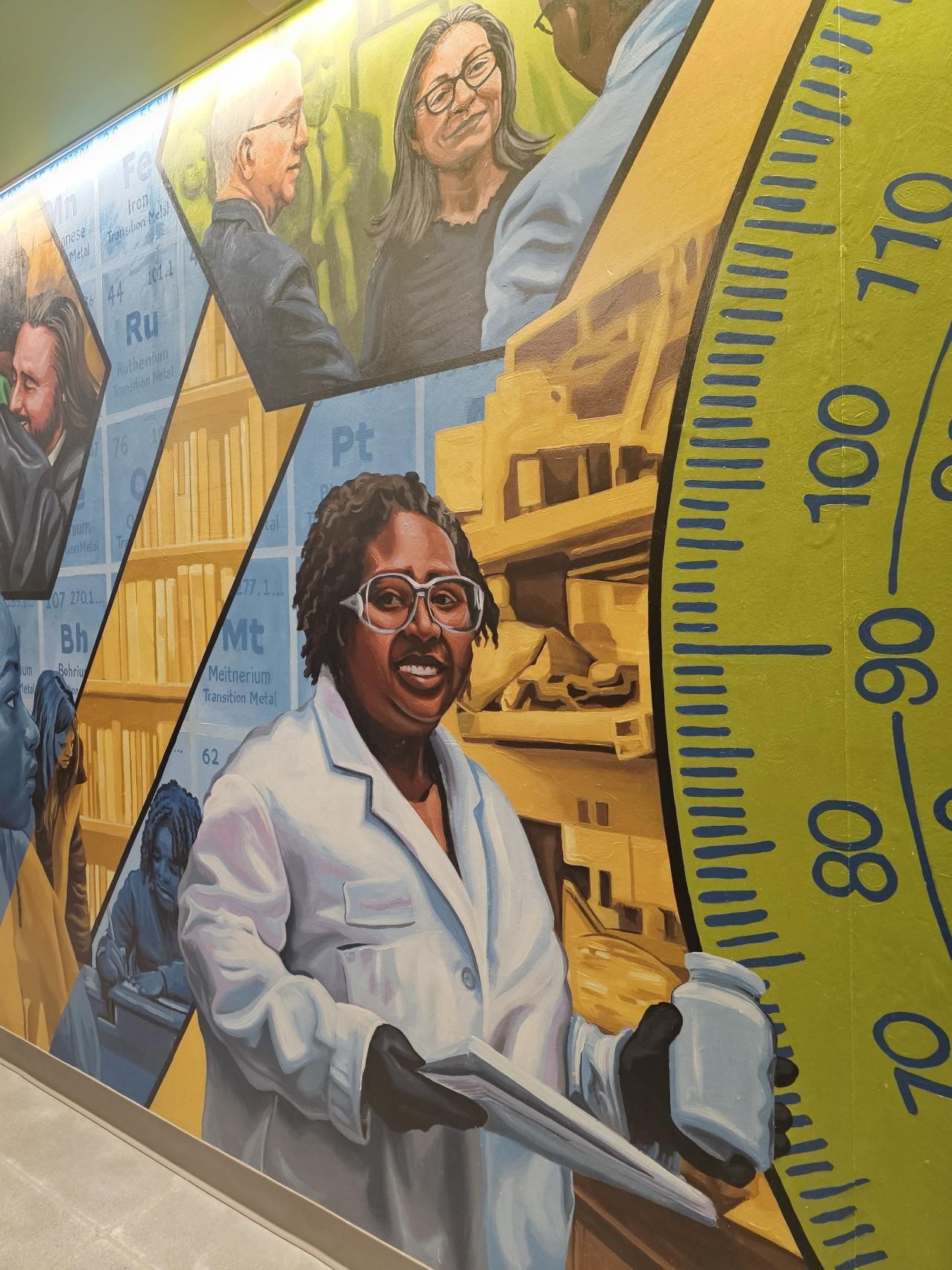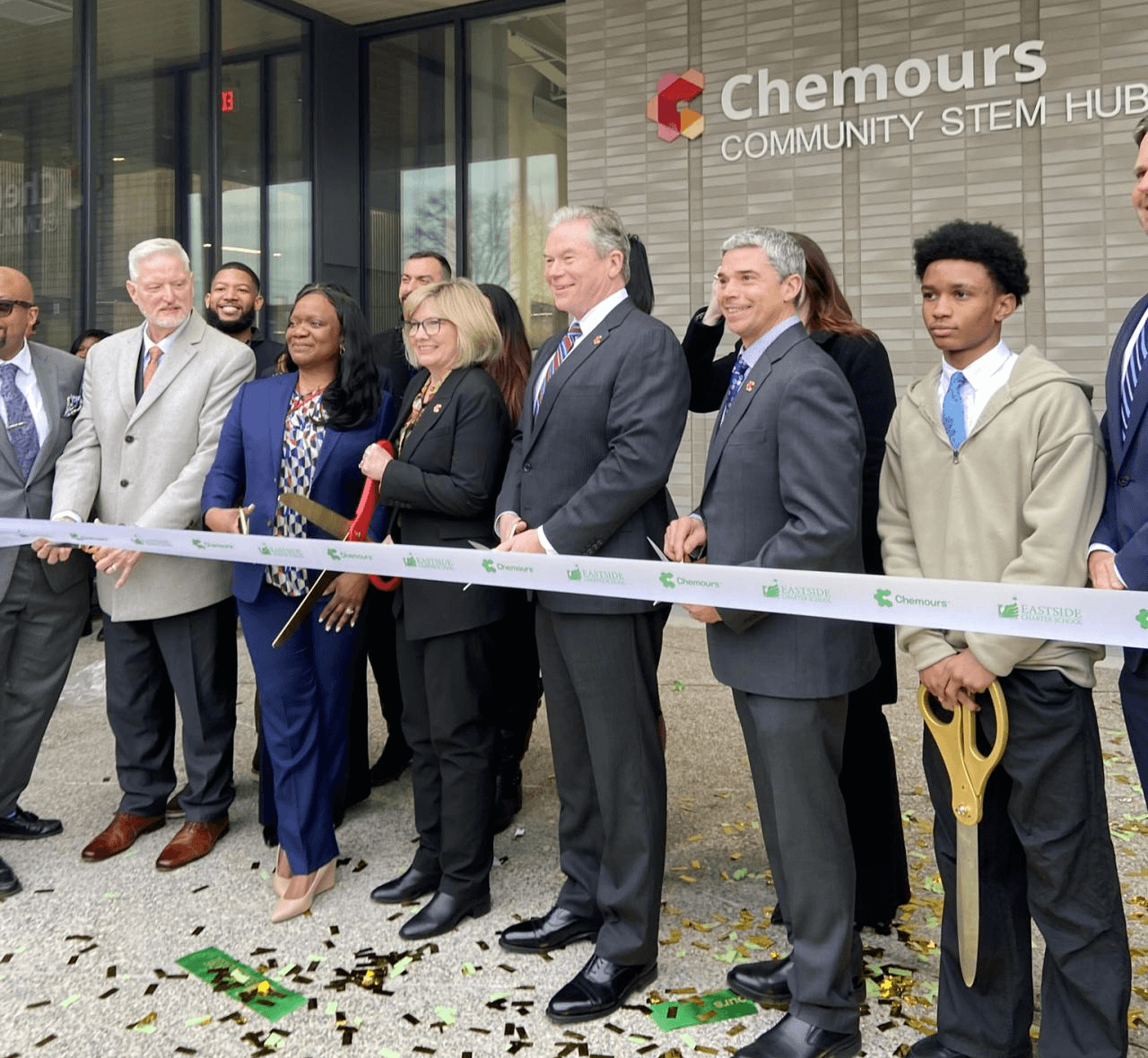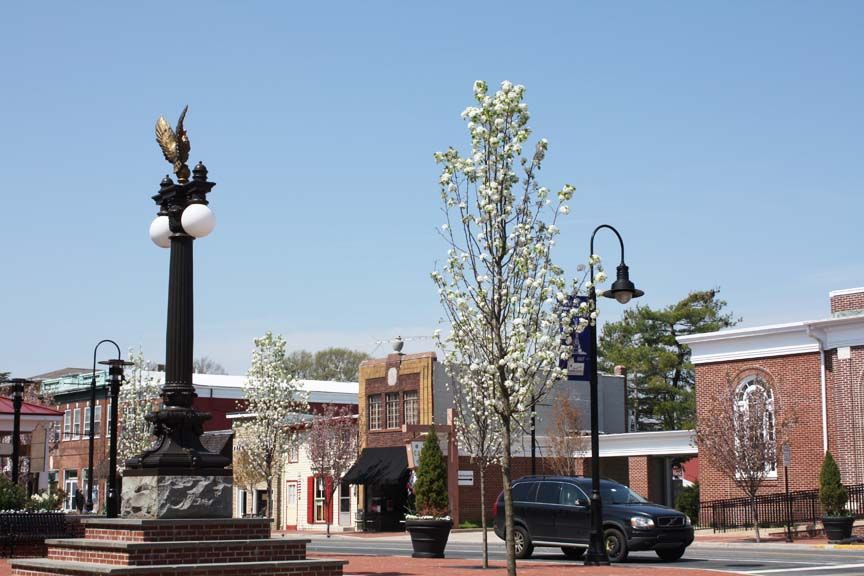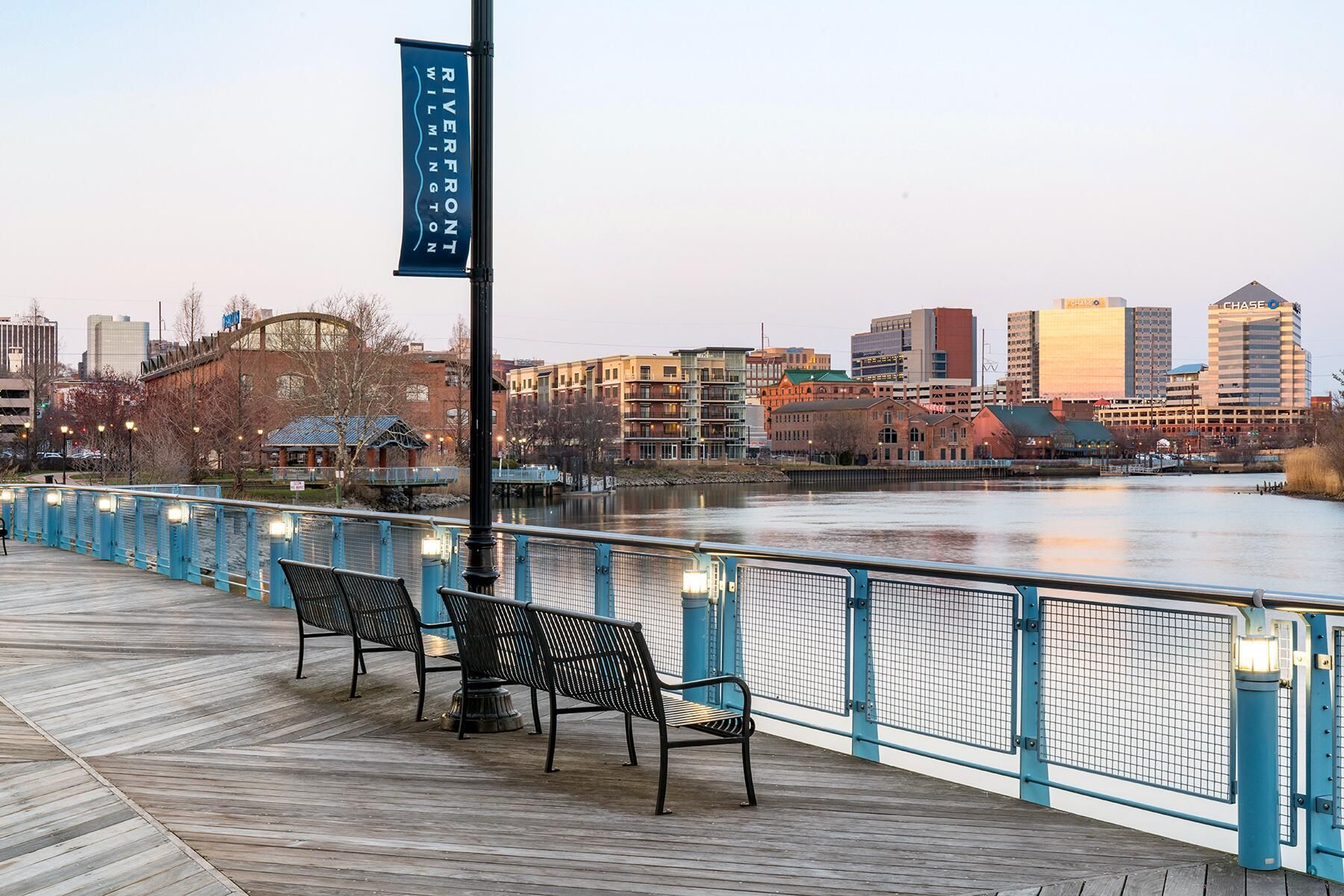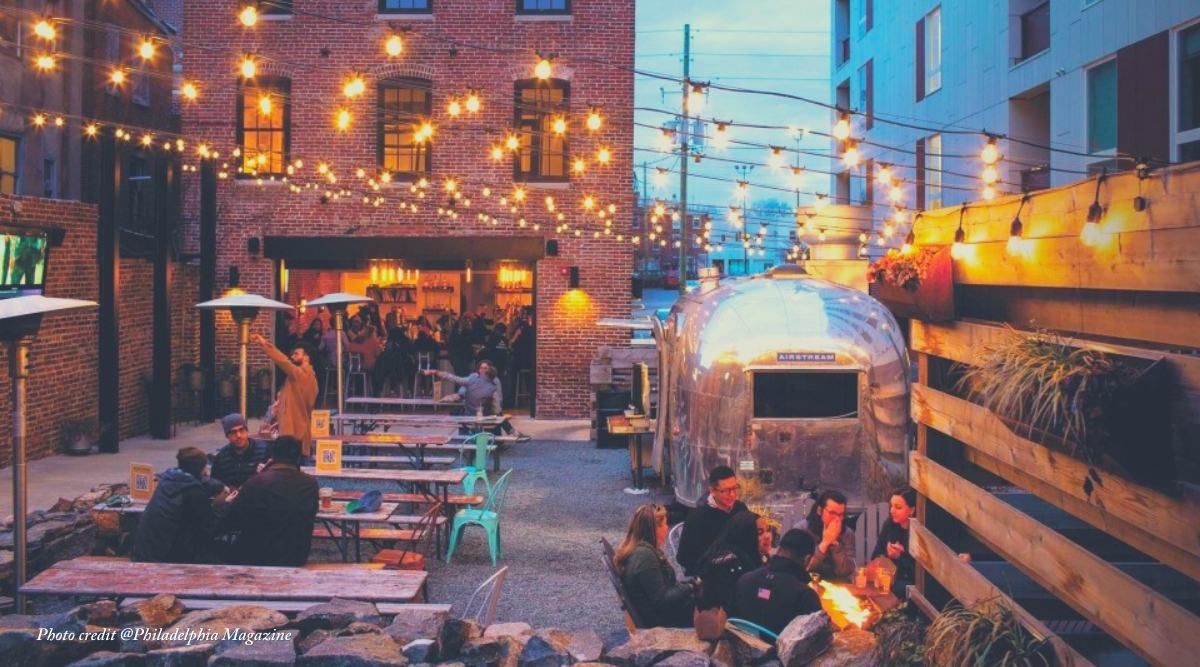Thanks to a resurgent downtown — the passion project of a pair of native sons — and a red-hot dining scene, our region’s second city is building quite the buzz. What does that mean for Philly — and for Wilmington?
The bar is three or even four people deep, making it tough to get through the door. Inside, millennials and boomers alike are sipping fancy cocktails and bubbly, eager to catch a glimpse of four-time James Beard Award winner Andrew Zimmern, whose Bizarre Foods show ran for a dozen years on the Travel Channel.
If you didn’t reserve a table weeks ago, you’re not getting in. Though this is mid-February, it’s the warmest night of the year — and anyway, for everyone here, the weather doesn’t matter. It’s a once-in-a-lifetime opportunity. Those in the dining room know it, and so does the giddy kitchen crew. They huddle up like a football team anticipating kickoff and let out a “woo” before service starts.
Zimmern flew in to raise money for the Independent Restaurant Coalition, which formed during the pandemic to lobby Washington for restaurant funding. He’s collaborating here with Bardea’s chef, Antimo DiMeo, to serve 90 guests at $275 a head. A neighboring hotel generously lent dozens of extra glasses to accommodate the night’s five wine pairings.
A big mix of people has turned out, from flannel-clad hipster types to ladies in little black dresses to empty nesters clinking champagne flutes as they’re seated. At one point, I look out the window as a white Maserati Spyder pulls up for the valet.
I’ve been a food writer in Philly for the better part of a decade. I get to go to dinners like this often. And here I am, enjoying my lightly cured Wagyu beef cheek carpaccio and surf clam with sustainable caviar — but I don’t know anybody in the room.
That’s because I’m not in Philly. I’m in Wilmington, Delaware.
I KNOW WHAT YOU’RE THINKING. When I mention checking out Wilmington to Philly friends, reactions have ranged from “Oh. Really?” to “F*** no.” I get it. I’m a born-and-raised Philadelphian, and I had never been to Joe Biden’s adopted hometown before 2020.
For decades, the 17-square-mile city was known primarily as the home of DuPont, a land of banks and businesses, a tax haven … and not much else. Everyone there used to say of Wilmington that at 5 p.m., they rolled up the sidewalks.
I came for the food. When Philly chef Tyler Akin opened Le Cavalier at the historic Hotel du Pont, I hopped on I-95. When DiMeo’s Bardea landed on the 2019 James Beard Award semifinalists list (a feat it repeated this year), I took another drive to Wilmington. I became hooked. I found a downtown with spacious restaurants and bars, freshly paved roads, striking architecture, and streets as clean as Disney World. Though it’s approximately 40 minutes from crowded, trash-challenged, noisy Center City, where I live, this place felt a world away from Philly.
“We’re becoming Philly’s hip little cousin,” says Tim Furlong, NBC 10’s Delaware bureau reporter and a native of the area. “Wilmington is on the cusp of something enormous.”
Of course, downtown Wilmington’s 10-block main drag isn’t enormous, but it’s got the makings of “the next Fishtown,” as Bardea co-owner Scott Stein, a longtime Philly restaurateur and bar owner, puts it. The past decade brought destination restaurants, an urban beer garden, a live music venue, and a growing collection of independent businesses, many of them owned by Black entrepreneurs. Market Street is home to coffee shops, art galleries, a juice bar, a leather-goods atelier, boutiques, a tattoo studio catering to BIPOC and LGBTQIA clientele. That’s all on top of the city’s existing attractions, which include a waterfront park, a pretty riverwalk, Underground Railroad sites, bike trails, professional theaters, art museums and nearby gardens.
They don’t roll up the sidewalks anymore. Downtown Wilmington’s millennial population increased by nearly 15 percent between 2014 and 2019.
It’s no fluke. Over the past two decades, two Wilmington-native brothers and their now-powerhouse company, Buccini/Pollin Group (BPG), have invested $1.6 billion into developing the city’s downtown. They’ve filled 3,100 new apartments, personally recruited top chefs, and opened their own entertainment and sports venues.
Guess where a third of BPG’s newest residents came from? Pennsylvania.
As millennials left dense cities in search of comfier, cheaper and, perhaps, less COVID-stringent work-from-home locales during the pandemic, many found downtown Wilmington. Companies, particularly in the fintech space, with its high-paying jobs, are following them.
The last time Zimmern was in town, eight years ago, he found a Wilmington that was “a little bit down on its luck.” And today? “Wilmington is where Birmingham was 10 years ago, when you could sense something really big was happening,” the celebrity chef tells me. “There’s still a lot to be done here, but you can feel the energy.”
Philadelphia has pretty much always existed in New York City’s long shadow, but in the Delaware Valley, we’ve been the only game in town. Now, here comes Wilmington.
Our little cousin is growing up. Should Philly watch its back?
EVERYONE IN DELAWARE’S BIGGEST CITY BRAGS about its accessibility. It’s right off I-95, it has a busy Amtrak station, it’s closer to Philly’s international airport than many Philly suburbs, and it’s a quick trip away from New York or Washington, D.C. Though the population is just over 70,000, some 50 million people live within a 250-mile radius.
But before planes, trains and automobiles, the area’s waterways — the Delaware, the Christina, the Brandywine — brought people and industry to Wilmington. That’s why, legend has it, Thomas Jefferson called this a “jewel” among states — which might be where its nickname of “the Diamond State” originated.
More importantly, access to the Brandywine River is why Éleuthère Irénée du Pont de Nemours set up his gunpowder works in Wilmington — the inception of his family name becoming synonymous with the city. “They were the largest supplier of gunpowder to all the Allies for World War I and World War II. Then they started branching out more broadly to chemistry. And they bought a big interest in General Motors in 1910,” Ben duPont, a seventh-generation member of the family and a Wilmington native, tells me. “Their products are from nylon to Lycra to Teflon to Kevlar and on and on and on.” (Apologies to the strict grammarians: Everyone in the DuPont/duPont/Du Pont orbit styles the family name differently.)
Easily one of the most important companies in American history, DuPont at one time employed tens of thousands of downtown workers. The family’s wealth created a rich cultural infrastructure — theaters, museums, gardens, a grand opera house.
By the 1940s, more than 112,000 people lived in the city. Then I-95 moved in. In the 1950s and ’60s, construction of the major highway cut the city in half. Hundreds of homes and two churches were demolished — and the city found itself segregated, mostly along racial lines. Crime in impoverished neighborhoods rose and ushered in the “white flight” that many cities experienced in the second half of the 20th century.
Things went downhill from there.
“Wilmington has the dubious distinction of being the domestic city with the longest martial occupation,” says Ashley Cloud, club executive for the Rotary Club of Wilmington and a local history enthusiast. After the assassination of Martin Luther King in 1968, a peaceful vigil led by clergy in Rodney Square, in the shadow of DuPont’s downtown HQ, was followed by fires, broken windows, rock-throwing — disorder that many cities experienced after the tragic killing. The governor sent in the National Guard, which restored order in a couple of days — and then set up camp.
“The National Guard doesn’t leave us for nine months,” Cloud explains. “Nine months of guards patrolling with rifles, crow’s nests on top of some buildings, enforced curfews … ” She says the emotional ramifications of that occupation are still with Wilmingtonians, especially in Black neighborhoods. It also sent more residents running to the ’burbs. By the 1980s, nearly half of the pre-I-95 population had fled, taking their tax dollars with them.
It was time for a pivot. In 1981, Governor Pete duPont (that’s Ben’s dad) signed a bill that liberalized restrictions on credit-card banks. Within months, nearly a dozen had moved in, bolstering a local financial-services industry that employs 40,000 people.
Low taxes at all levels — Delaware has no sales tax, no inventory tax, the fourth lowest property taxes in the U.S., and low corporate taxes — have made this the place to be for businesses. Wilmington is headquarters for two Fortune 500 companies and five more in the Fortune 1,000. It’s also “home” to tens of thousands of other businesses that incorporate there yet maintain little more than a P.O. box. In 2012, the New York Times wrote that Delaware had more corporate entities than people. Two-thirds of all Fortune 500 companies are incorporated there, according to the Delaware Prosperity Partnership. Google “Corporate Capital of the World” and Delaware comes right up.
Of course, that means Wilmington is hit harder than peer cities during recessions, when governmental policies change, or when companies merge/close/relocate.
In the early 2000s, MBNA employed more than 10,000 workers in Delaware, making it the state’s largest private-sector employer, according to the Delaware News Journal. At one point, “Almost every American had an MBNA-issued credit card,” Cloud says. Then, Bank of America bought the giant and began selling off MBNA’s assets. More empty buildings.
Even when bank business was booming, that success didn’t translate into an exciting downtown. “We didn’t have anybody living here,” the city’s current mayor, Mike Purzycki, recalls. For decades, Market Street, Wilmington’s 10-block main drag, looked nothing like it does today. Wilmington native Oba Jackson, now the owner of Push Tattoo Studio just off Market Street, remembers the area as a “ghost town” that opened at around 11 a.m. and closed at 5 p.m.
As the downtown goes, so goes the rest of the city. Crime rose, and poverty increased.
In 2014, Newsweek ran a now-infamous headline calling Wilmington “Murder Town USA” after a record 27 homicides were committed in the city of around 71,000 residents. That number may sound low to Philadelphians today, but it was more per capita than our record high in 2021. Crime was, and still is, a problem for Wilmington. In this way, it’s no different from any other city in the COVID era.
That same year, DuPont abruptly moved its headquarters out of downtown Wilmington, presenting an existential crisis for the city that had been linked with the chemical giant for 107 years.
“You would think the whole city would have fallen in like a deck of cards when they left, but we didn’t,” Cloud recalls. “The same thing with MBNA. It was shocking, sure … but Wilmington is pretty nimble at recovering.” Enter the Buccini brothers.
ROB BUCCINI AND I ARE RUNNING IN AND OUT of construction sites. We’re in the skeleton of what will soon be a 24-room luxury hotel in a Frank Furness-designed brownstone. Though we’re getting the side-eye from carpenters and electricians, Rob, 53, in a new blue suit and brown leather dress boots, isn’t shy. He grew up in a construction family. He fist-bumps people as we walk through their work zone to get a look at a subterranean bar they’re building.
I’m in town for a tour with Rob and his brother Chris, 50, the Wilmington natives who’ve changed the face of the city by investing in its downtown over the past two decades. We start our drive in the leafy neighborhoods north of downtown, with their mix of townhouses and stately homes. Once we cross I-95 into downtown Wilmington, excitement builds in the cab of Rob’s black Yukon. The brothers are pointing out construction cranes, buildings, and empty lots set to become something new. Occasionally talking over each other, Rob and Chris have a lot to show off.
The Queen, a centuries-old concert hall at 5th and Market that seats 400, stood vacant for 55 years — so long that when BPG took over, the roof was barely there, and a “colored section” sign from the 1950s still hung in the balcony. The Queen has that frozen-in-time feeling, like Philly’s Divine Lorraine and the Met. Today, it hosts monthly drag brunches and local comedians, and it recently played host to the likes of Ingrid Michaelson and the now-late Biz Markie. The venue’s manager, Sam Blumin, just left a job with Live Nation in Los Angeles to come to Wilmington.
At the top of Market Street, the 217-room Hotel du Pont was built in the early 1900s as part of DuPont’s corporate headquarters. It’s grand, with 12 stories of Italian Renaissance architecture outside and Gilded Age design on the inside. BPG bought it from DuPont in 2017 and has since added DECO, a food hall and bar that’s just as popular among the lunch crowd as with the happy-hour set, and Le Cavalier, a French brasserie helmed by Wilmington native Tyler Akin, known for Philly restaurants Stock and Res Ipsa, two now-closed Best of Philly winners.
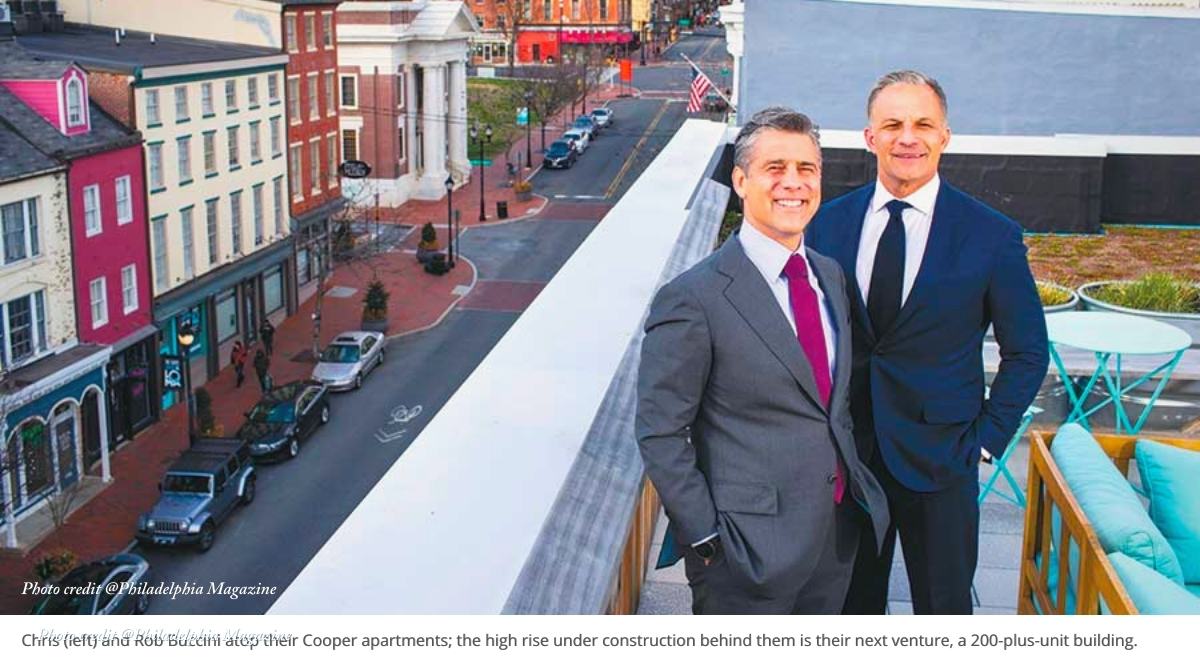
Over the years, the Buccinis have learned that if you want something done right, you do it yourself. That’s how they ended up not just owning but running the historic hotel — and a host of other Wilmington attractions that draw people to the city.
With properties — office buildings, residential buildings, retail, sports, entertainment, and about 50 hotels, including brand-new Virgin Hotels in Nashville and New Orleans — throughout 22 states, Rob and Chris bring the best ideas they find in other places back to Wilmington. They especially like affordable cities with pro-business governments, great food scenes, and “a ton of hometown pride.” They’re modeling nightlife and entertainment offerings in Wilmington after newly hip cities like Nashville, Greenville in South Carolina, and Durham in North Carolina.
Nashville is where Chris got the idea for Maker’s Alley, a downtown indoor/outdoor bar. BPG also opened and runs the city’s first beer garden, Constitution Yards, on the riverfront. The company’s newest downtown destination, Wilma’s, features bowling and New Orleans-themed fare in a former bank. Across the Christina River from downtown, we head to BPG’s three-year-old, 161,000-square-foot indoor sports complex. It’s home to a 2,500-seat arena where the 76ers’ G League team, the Delaware Blue Coats, plays, along with a full-size soccer pitch that’s been drawing youth sports tournaments to Wilmington.
Outside, BPG recently added emerald green turf fields with stadium lighting. We’re on the edge of one of the city’s lower-income neighborhoods, Southbridge, and you can see public housing from the fields. Hanifa Shabazz, a former City Council president who heads up the nascent Southbridge CDC, says the group is “organizing quickly to make sure that we are at the table” as development continues and is focused on transportation, education, housing and infrastructure goals. BPG has begun programs with local kids in an effort to democratize the sparkling compound. But it’s a stark visual reminder of the socio-economic duality Wilmington still faces, and the challenge of equitable growth.
I MET SONDRA WOODRUFF outside her apartment building on lower Market Street. She was walking her Maltese, and I was checking out the architecture. You can’t miss the Cooper, a BPG building with a cast iron facade built in 1874 and a Scandinavian-influenced courtyard. A onetime recording artist who toured with the Backstreet Boys, Woodruff moved to Wilmington for a job with a leading financial institution.
The Pittsburgh native, by way of Manhattan, had never been to the city before. “Everyone asked why Wilmington, and I asked why not?” she says. She liked the idea of moving to a city with a majority Black population and loves that there are Black-owned businesses right on her street. As a musician, she’s been enjoying the city’s live-music venues, street fairs with bands, and summertime jazz festival. Woodruff likens her neighborhood to a small Manhattan strip, “like the East Village or something.”
Back in 1999, when the Buccinis bought their first property, the Wilmington that Woodruff describes would have felt impossible. “Everyone in Delaware was like, ‘You guys are crazy’,” Chris remembers with a laugh.
That’s because at ages 31 and 27, Rob and Chris borrowed $25 million to buy two of DuPont’s downtown headquarters buildings, Nemours and Brandywine. Goldman Sachs was also bidding, but DuPont picked the local brothers. “I had $70,000 in credit-card debt, I was in a one-bedroom rental, no wife, no kids, a leased car,” Rob says. Or, as Chris puts it, “We had no money” and “no idea what we were doing.”
They’d both been working in New York City after college — Rob in construction/development and Chris at a real estate investment bank. Coming from a construction family, both always knew they’d work in the industry and would eventually land back in the Wilmington area.
The DuPont deal wasn’t so much a triumphant return home as a leap of faith — at a time when no one was betting on Wilmington. Few people lived downtown, which struggled with crime and with vacancy, especially in its historic buildings. As DuPont gradually left town, even office buildings were emptying. “We were on the tipping edge of becoming Camden or Chester,” Ted Blunt, another former Council president and a North Philly native, recalls. Like Wilmington, those cities once thrived as industrial hubs with busy commercial waterfronts but fell into disrepair as industry left in the late 20th century.
Call it luck or strategic long-term thinking, but DuPont did leave the city with a gift: As part of the deal to buy the office buildings, BPG had to build 55 apartment units downtown. “No market-rate housing had been built downtown in half a century,” Chris says. “DuPont wanted to do a little something to help spark a fire.”
With tens of thousands of people working downtown, there was hope that at least some would want to cut their commutes and walk to work. To everyone’s surprise, those units filled up. So the Buccinis took it to the streets. “Door by door, we went and knocked and bought 28 buildings on Market Street. We wanted to create this district that was authentic, organic, no chain restaurants — the anti-mall, basically,” Chris says.
Cue the Field of Dreams reference: With each apartment building the brothers built, new people moved downtown. Most were young professionals working in the area’s banks, law firms and hospitals. Yet downtown’s streets still emptied on nights and weekends — you couldn’t even get a cup of coffee on a Sunday morning at one point. “The one thing that was missing from downtown Wilmington was people,” former mayor James Baker, whose three terms, from 2001-2013, coincided with BPG’s early development, told Rob and Chris.
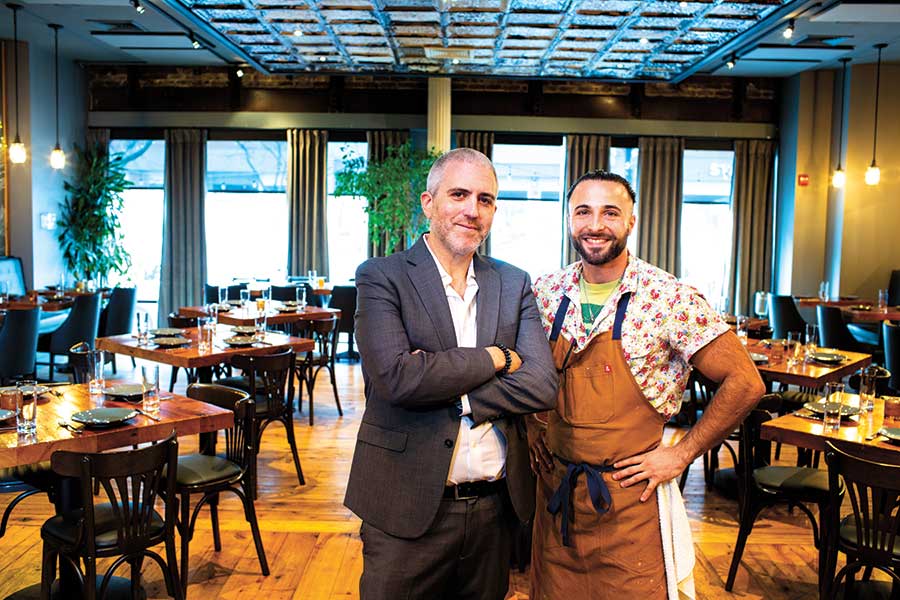
Bardea restaurant owners Scott Stein and Antimo DiMeo.
Chris remembers saying, “Rob, there’s nothing to do after work. We need six new bars.” Enter Merchant Bar, Constitution Yards, Stitch House Brewery, DECO, Maker’s Alley, Wilma’s — all opened in the past five years. BPG took care of that caffeination issue, too: It now operates two Starbucks locations and its own cafe, I.M. Coffee.
Over the years, the brothers personally recruited popular restaurateurs to open downtown. “It started with Brian Sikora, who was at A.Kitchen and took the leap to come into downtown Wilmington to open La Fia,” Rob says. “Then the late Scott Morrison of Chelsea Tavern, Antimo and Scott at Bardea, Tyler at Le Cav, and now the Mulherin’s people” (more on that later). And since no one wants to drive home after a night out, a soccer tournament at the Fieldhouse, or a concert at the Queen, BPG built the city’s first new hotels in decades. The company that started out as a couple of guys who had no idea what they were doing has grown into a $6 billion operation, with more than 900 employees in Wilmington (and another 3,100 total nationwide).
They’re following in DuPont’s footsteps, and like that storied company, Rob and Chris try to think long-term. BPG has bought about 90 buildings downtown and still owns all of them. The brothers talk a lot about hometown pride, and you can see it on their faces as we speed-walk through their projects — even the ones that haven’t broken ground yet. They have a vision for their Wilmington. “We’re trying to create all these things for people to do, because at the end of the day, entertainment and food — that’s what changes cities,” Chris says.
LIKE ANY GOOD LITTLE COUSIN, Wilmington is taking pages from Philly’s playbook. We revitalized our downtown decades ago — an effort led by then-mayor Ed Rendell in the ’90s. Center City District’s Paul Levy, who has been involved since then, walked me through the plan: Recruit restaurateurs, create entertainment offerings, build apartments, keep people in town after work, appeal to business and leisure travelers, create tax incentives for development. Philly did it all, and it worked.
Yet the past few years have changed Philly’s appeal for some city-dwellers. Crime is proliferating, the trash problem is intensifying, loud off-road vehicles sometimes seem to rule the streets, the cost of living is increasing, and there’s a growing sense that the local government has thrown in the towel.
People like me are deciding whether to stay or go … and Wilmington knows it.
Take the trash issue.
“Keeping Wilmington clean has been a priority of my administration from day one,” Mayor Purzycki told me. The city partners with nonprofits to clear litter from downtown and residential neighborhoods. It has also cracked down on illegal dumping, sweeps the streets regularly, and recently distributed new trash bins to 21,000 homes.
Rob Buccini, known around town for picking up stray litter, says Wilmington’s cleanliness “will be one of my legacies.” He’s been a squeaky wheel about it for years.
BPG also stations security guards around town, because, Rob explains, clean and safe streets set the tone for visitors and potential residents. That’s why the parking garages are brightly lit, with cameras all over — and a 24-hour command center that actually watches them: “We want people to feel as safe as possible.”
Restaurant owners I spoke with echoed Rob’s point about cleanliness and safety — and say they’ve found Wilmington an easy place to do business. Want a liquor license? In Delaware, that’ll be a few grand. In Philadelphia, that’ll be a few hundred grand — via a complex, inequitable process.
The phrase “pro-business government” came up a lot in my interviews. Both the Buccinis (big business) and Oba Jackson, the tattoo-studio owner (small business), tell me that getting permits is pretty easy (in Wilmington, at least; Jackson found the state government unhelpful when he opened his business). It’s a far cry from Philly’s web of complications and dearth of customer service that can make life hell for entrepreneurs.
The ease of doing business is part of why Bardea’s Scott Stein says he and partner DiMeo haven’t even entertained offers to open restaurants in Philly, New York City and D.C. They recently doubled down on Wilmington with pizza and taco stalls in the DECO food hall — and a big-time steakhouse opening this spring.
Mayor Purzycki has made responsiveness a priority, from fixing potholes to wooing new employers, he says: “If you’re an out-of-state CEO, I’ll get back to you in five minutes. Give me another 15, I’ll get the governor on the phone. I know you can’t do that in Pennsylvania, and I know you can’t do that in New York.”
That’s one reason Investor Cash Management, a growing financial-services technology start-up, recently moved its headquarters from Chicago to Wilmington, says CEO Fred Phillips. He considers Wilmington “the payments capital of the U.S.” and adds that the state and city governments “are spectacularly supportive of new technology companies.” ICM plans to hire 395 new employees — and recruit talent from Philly. Phillips also considered San Francisco, Austin, Miami, Chicago and New York but found Wilmington a “Goldilocks solution of a city,” with quality housing, schools and restaurants that make it a “very comfortable, very livable city.”
M&T Bank’s regional president, Nick Lambrow, echoed Phillips’s thoughts: “People could live in Pennsylvania and come in, but we’re finding that people like Delaware. It’s an affordable place to live, and it’s a safe place to raise children.”
Those leafy neighborhoods I mentioned and the close-in suburbs — places like Trolley Square, the Highlands and Alapocas — offer reasonably priced homes, half the property taxes of the Main Line, and a quick drive into downtown Wilmington for work or play. Compare that to Ardmore or Bryn Mawr, where home prices have soared, taxes are high, and you have to sit on the Schuylkill to get downtown. Consider Wilmington’s accessibility and hot new restaurants, and you get an attractive market.
A BPG executive tells me that 32 percent of its newest tenants moved to Wilmington from Pennsylvania — 13 percent from Philadelphia specifically.
Local real estate broker Chris Patterson says his busy brokerage sells a lot of homes priced around $500,000 — an affordable mortgage for many families. He also notes that transplants are coming from New York City and the West Coast: “They can go from a postage stamp of seven figures-plus in California to three, four, five acres-plus here in Delaware.”
WHEN RICK FITZGERALD RETIRED during the pandemic, he and his wife left East Passyunk in Philly in search of more space and greenery. “We didn’t know Wilmington other than all the great gardens,” he says. Before moving, the food-loving couple frequented Noord and Fond — both of which, it’s worth noting, closed in the past year. “We just assumed we would have to journey back to Philly for great restaurant experiences,” Fitzgerald says. Then they discovered the dining scene in their new backyard.
Gerald Allen Jr., who teaches culinary arts at a local vo-tech high school and sells coveted smoked chickens and noodle soup at pop-ups, used to drive to Philly a few times a week for dinner. The classically trained chef ate at all our top spots but lately has been staying close to home. From takeout tacos and pizza to fine dining, he’s found plenty of good food right in Wilmington.
Center City District’s Levy isn’t too worried about the competition from Wilmington but notes that Philly needs to get better at retaining young people and make it easier to get things done, “whether it’s getting a business license, a liquor license, a building permit” — all of which appear to be driving Wilmington’s resurgence.
Of course, Wilmington is much smaller than Philly. Yet if there are businesses that would have opened here but found it easier to be there, Levy says, “Philadelphia should be concerned. That’s good for Wilmington, but it’s a lesson for Philadelphia.”
Even with a bustling downtown, restaurants and concert venues aren’t enough to revitalize a city. And like Philly, Wilmington has a chasm between the haves and have-nots. More than a quarter of its population lives in poverty, according to the latest census numbers. Violence has long plagued historically Black neighborhoods. In 2021, the city far surpassed the 27 murders that drew the “Murder Town” headline, with 39 killings — “all in a handful of low-income neighborhoods that essentially encircle the central business district,” as WHYY put it.
Though the area has elite private schools and a good charter-school network, the city’s education system doesn’t meet everyone’s needs. Wilmington doesn’t have a traditional public high school. You read that right. There’s a charter school and a vo-tech school, but, Mayor Purzycki admits, “We need a city high school.”
With so many young professionals moving into town, I wondered about gentrification and the displacement of longtime residents. “It’s nowhere on the radar screen for us,” the mayor tells me. The city government has “considerable influence over development” and won’t let developers take over residential neighborhoods, he says.
“Sure, we want to create an environment where BPG and many other people want to develop,” Purzycki says. “But our major focus has to be on that part of our community that’s hurting.” An immediate step: His administration is directing $40 million of its American Rescue Plan Act funding into residential neighborhoods, to clean up blight and help longtime homeowners with needed repairs.

Jackson, the tattoo studio owner, calls what’s going on “rejuvenation,” not “gentrification.” He worries, though, that the latter may be coming next, mentioning that his daughter was recently priced out of her apartment and that several of his friends report being unable to afford rising downtown rents that were reasonable a few years ago. As we’ve seen over the course of Philadelphia’s downtown resurgence and the waves of development it’s spurred, there’s a delicate balance to promoting growth in a way that includes, rather than displaces, the people and businesses who were there before.
Wilmington has problems to solve, and it needs to get this part right, but it’s a “big bucket of potential right now,” NBC 10’s Furlong says. “If they can figure out some of the issues that plague the city, the sky’s the limit.”
Throughout my reporting for this piece, I kept coming back to a question: Is Wilmington putting all its eggs in BPG’s basket? For years, the city depended on DuPont’s outsized presence; then, one day, it was gone. Same thing with MBNA. Is Wilmington becoming a BPG company town? Could history repeat?
Mayor Purzycki says I have it backward: “They’re putting a lot of eggs in the Wilmington basket.” If BPG disappeared tomorrow, the infrastructure it has built would remain, and that’s what matters, he says: “You don’t pick up the Hotel du Pont and take it with you.”
About that DuPont legacy: I ask Ben duPont if his family’s looming presence will fade as Wilmington diversifies and grows. “I hope it’s known for other things,” he quickly answers. A tech entrepreneur himself, Ben founded the nonprofit coding school Zip Code Wilmington and recently bought the DuPont Country Club with the goal of making it more accessible to working families. “While I’m certainly proud of my family’s fingerprints over 200 years,” he says, “I think cities should live and grow.”
And the growth seems set to continue.
BPG delivers about 500 new apartments each year — often opening its new buildings with waitlists. Tech companies and other employers are coming to Wilmington. Mayor Purzycki goes to so many ribbon-cuttings — for businesses big and small — that he’d be smart to buy stock in the company that makes those oversize scissors.
In late summer, the chic boutique hotel that Rob and I walked through will be open, operated by Philly’s Method Co., with a Wm. Mulherin’s Sons-style Italian restaurant, Wilmington’s first rooftop bar, and an underground cocktail lounge.
An 86-acre plot of now-empty land, Riverfront East, will soon become a $100 million development — that will grow to $1 billion-plus by the time it’s done, according to Rob Buccini. It’s being modeled after Philadelphia’s Navy Yard, with offices and apartment buildings — and the plan is to provide jobs and housing opportunities for its Southbridge neighbors.
Wilmington is also considering capping I-95 — something many residents believe would reunite the city physically and psychically and perhaps begin healing some of those old wounds.
Wilmingtonians new and old talk about the city like they’re in on a secret no one else has discovered — though real estate and population trends tell us that’s changing. Delaware’s population is growing — by 10.2 percent over the past decade, faster than that of any other state in the Northeast. Pennsylvania only grew 2.4 percent over that period, and it lost population during the pandemic, while Delaware gained new residents. COVID only accelerated an ongoing movement of Americans to lower-density, lower-tax places like Wilmington.
Should Philly be worried about competition from its hip little cousin?
I gave Wilmington’s former City Council president, Ted Blunt, a good laugh with that question. “I don’t think Philadelphia has anything to worry about,” he told me, still chuckling.
Wilmington could probably snag some of our chefs, cool citizens and cachet to become that “next Fishtown.” But at just an eighth of our size, it would be hard for our neighbor to become an actual threat to Philly.
Rob Buccini suggests thinking about it more broadly. Wilmington’s growth is good for Philadelphia, he says: “I think a rising tide lifts all boats.” Besides, in his view, it’s more like our region against other regions — Philadelphia and Wilmington together competing with Dallas-Fort Worth or Raleigh-Durham.
Us — Philly and Wilmington — vs. everyone else? Now, that’s something Philadelphians can get behind.
Delawhat?
Five facts you probably don’t know (unless you’re from Delaware)
1. Count your clucky stars: Locals like to say Delaware is known for four C’s: chemicals, corporations, credit cards and chickens. Yes, chickens. Two hundred million of ’em. The state supplies poultry to much of the Northeast and Mid-Atlantic.
2. Delaware was once a part of Pennsylvania! When William Penn first came to America, in 1682, he landed in Delaware and assumed it was part of his land grant. Just after the country declared its independence from the British in 1776, Delaware followed suit and separated from Pennsylvania. It became the first state in 1787. Pennsylvania still acts like it doesn’t care.
3. At just 1,982 square miles, Delaware is very nearly the smallest state, bailed out only by Rhode Island.
4. Although fewer than a million people live in Delaware (989,948 per the 2020 census—it’s getting there!), it has more patents per capita than any other state and is where the majority of Fortune 500 companies and new IPOs are incorporated.
5. Sure, we know President Biden is a Wilmingtonian, but a slightly cooler figure also once called it home: Reggae icon Bob Marley lived there on and off between 1965 and 1977.
Published as “The It City Next Door” in the May 2022 issue of Philadelphia magazine.


